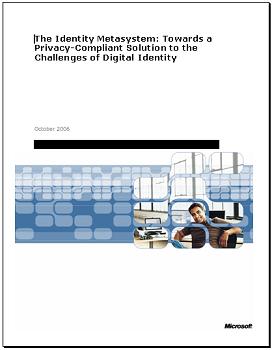Tom Raftery at http://www.podeladers.com/ interviewed me recently for his PodLeaders show (42 mins 15 secs). Here is his description of what we talked about:
My guest on the show this week is Kim Cameron. Kim is Microsoft’s Identity Chief and as such is responsible for developing CardSpace – Microsoft’s successor to the much reviled Passport. Kim elucidated the Seven Laws of Identity and is developing CardSpace to conform to those laws. If he manages this, he will have changed fundamentally how Microsoft deals with people.
Kim is also responsible for Microsoft recently releasing 35 pieces of IP and promising to never charge for them.
Here are the questions I asked Kim and the times I asked them:
Kim, I introduced you as Microsoft’s Identity Chief, what is your official title in Microsoft? – 0:35
What does the Chief Architect of Identity do in Microsoft? – 01:02
Why is it necessary to have identity products in software? – 01:29
How do I know who I am dealing with on the internet? How is that problem being solved? – 03:56
And you as Microsoft’s Identity Architect are coming up with a way to resolve this called CardSpace… – 07:08
You were saying CardSpace is to be platform independent, I run a Mac, will it run on the Mac? – 15:26
You mentioned a couple of companies, are the offerings from these companies going to interoperate or are we going to have another version of the VHS/BetaMax wars? – 17:45
Audience questions
Rob BurkePerhaps more than any of the other Vista-era technologies, in order to really catch on, CardSpace requires broad cross-platform adoption. Kim personally is doing a lot to showcase the use of CardSpace’s open standards. What does the broader effort to engage with other platforms and communities look like, and how is CardSpace being received? – 21:10
CardSpace uses an intuitive wallet-and-credit-card metaphor. One of the features of a wallet is that it’s portable – I several pieces of identity with me at all times. I tend to move between computers a lot. What provisions are there in CardSpace for helping me keep mobile (in a secure way)? – 25:07
What happens if your laptop containing your InfoCards gets lost and/or stolen? – 28:00
What’s cooking on the identity managemnt front at MSFT? We’ve been hearing about this on and off for a while – we need progress if we’re not to be weighed down byt having to remember so many usernames and passwords for the servics we consume. – 30:35
My questions again:Will there be a lot of re-engineering of web apps required to roll out these technologies? – 34:03
And finally you mentioned that this is the first version what can we expect in the next versions and when will they be released? – 39:58
Download the entire interview here
(19.3mb mp3)
Let me make one thing clear about Microsoft's Open Specification Promise: many people were involved, and Microsoft's legal people, along with their colleagues representing open source thinkers aned companies, deserve all the credit.
Check out the other interviews on the site (I think I'm number 48). Doug Kaye was number 47, and there are lots of good things to listen to while on the treadmill (physical or metaphorical).





 Ontario's information and privacy commissioner says she supports a new global online identity system to protect consumers.
Ontario's information and privacy commissioner says she supports a new global online identity system to protect consumers.